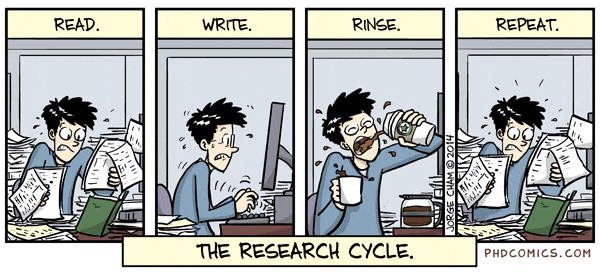One of the ChE GSA’s main goals is to provide you, a prospective, current, or former graduate student, with resources and answers to frequently asked questions. Please follow the links below to access these resources by topic area.
MS/PhD Curriculum
Advisor Selection
Funding
Reading Resources
Writing Resources
Miscellaneous
Life at Penn State and in State College
Accommodation in State College
The Chemical Engineering Graduate Student Handbook is the best resource for questions concerning the MS/PhD curriculum. Information about classes, exams, and TA requirements are all outlined in the handbook.
Students in their first semester of the program register for a 1 credit Colloquium (ChE 590), in which professors present the projects that they have to offer. Outside of the colloquium, students are expected to contact professors and arrange personal meetings to discuss the projects as well. At the beginning of October, students are asked to rank their advisor preferences. Each student is given 10 points to rank 3 projects. Professors then make a decision on who to take into their lab based on these rankings and any individual meetings that were arranged. Students are notified by the middle of October. Some students may not be given a project initially. These students are asked to rank the remaining projects and the process continues until each student has an advisor.
Tips for Success
1. You should choose the project that interests you most; you should not be influenced by the choices of your classmates.
2. You should cherish the opportunity to meet with professors. You can talk to the advisor you are interested in multiple times if you are really interested in his/her projects.
3. Be prepared before you talk to an advisor you are interested in. Go to the professor’s website and read a few papers that seem applicable to the project being offered.
4. Ask questions whenever a professor explains something that may not be clear. It is better to ask them before you are actually doing the project on your own.
5. Talk to a few of the graduate students in the lab. Ask not only about the research, but also about what it is like working for the professor.
6. Do not be frustrated if you did not get your first choice advisor. There are promising projects left unselected in the first round every year.
All PhD students are typically given as stipend for up to five years either through the department and/or your advisor. Many students find funding through fellowship or grant programs, which significantly improve your resumé and give you the opportunity to choose your own research direction.
Fellowships
Fellowships are funds that are used to support exceptional candidates with stipend, tuition, and, in some cases, research and travel funding. Being awarded a fellowship during your PhD is not only a significant achievement to be highlighted on your resumé and typically provides a higher stipend but also often gives you more freedom in choosing a research focus. Your advisor will work with you to develop a research focus that you both will enjoy and find beneficial.
Our department offers an excellent fellowship, the McWhirter Fellowship. Other fellowships can be found through Penn State’s Award Database and Science.gov’s Award Database.
Many fellowships are available to first and second year students. Some examples include the following:
● National Science Foundation’s GRFP
● Environmental Protection Agency’s STAR
● National Institute of Health’s NRSA
Other fellowships are available during later stages of your PhD and are called Predoctoral Fellowships or Doctoral Dissertation Improvement Grants. Some examples include the following:
● National Science Foundation DDIG
● USDA NIFA Predoctoral Fellowships
Tips for Success
1. Start thinking about your fellowship applications early. Applications typically require a significant amount of time to prepare (~2 months).
2. Give professors about a month notice for writing a letter of recommendation. Do not be afraid to ask professors whether they can write you a strong letter.
3. When writing a personal statement, use an interesting anecdote to illustrate your research interests as a graduate student.
4. When writing a research proposal, ask your advisor for details and relevant literature about your project if you are not already in a lab.
5. Apply to multiple fellowship programs to increase your chance of success.
Grants
Grant proposals are typically written by your advisor to organizations like NSF, DOE, DOD, NIH and USDA before you arrive at graduate school. You will then be paid and use research supplies purchased via one of these grants. During your later years of graduate school, some advisors may ask you to contribute in the grant writing process. This is an invaluable experience that every student should consider whether or not they seek an academic or an industrial career. To help your advisor search for various funding opportunities, seek Grants.gov for a current list of available funds.
How to read a paper efficiently: https://www.youtube.com/watch?v=IeaD0ZaUJ3Y
Guide to writing a good paper: 131.5_weitzlab_guide_to_good_paper_writing_10-2012
Writing a paper: 1375_ftp
How to write a paper in a weekend: https://www.youtube.com/watch?v=UY7sVKJPTMA
Ph.D. comics: http://phdcomics.com/comics/archive.php?comicid=2002
The Awesomest 7-year post-doc: https://blogs.scientificamerican.com/guest-blog/the-awesomest-7-year-postdoc-or-how-i-learned-to-stop-worrying-and-love-the-tenure-track-faculty-life/
Advice for early Ph.D. students: http://www.pgbovine.net/early-stage-PhD-advice.htm
Ph.D. motivation: http://www.nobelprizeii.org/video-category/advice-for-young-scientists/
What I wish my friends and family knew about my Ph.D.: https://www.nature.com/articles/d41586-019-00948-7?fbclid=IwAR02WYDaipcmS11m5KNSFbtCuHz2UDmCC-xCRZ4oB8WJcYMj6zQbxwV-Am0
What matters in a Ph.D. adviser? Here’s what the research says: https://www.sciencemag.org/careers/2019/04/what-matters-phd-adviser-here-s-what-research-says?fbclid=IwAR39AUV4Q6opdFOZwjvAUsY3GqYLp54CC4Pxn15u2iouDWWseu1bbWhZm2s
Life at Penn State and in State College
State College has a variety of entertainment options. The Central Pennsylvania Convention and Visitors Bureau provides a list of activities and places to explore. We highlight some of those activities and places below.
- Giant
- Weis
- Wegman’s
- Trader Joe’s
-
McClanahan’s
-
Target
- State College International Market
- Penn Halal Grocery
- Kirshan Indian Grocery Store
- International food stores
- East European Market
- Momezon Korean Market
Restaurants and Bars
State College has a number of restaurants and bars that can accommodate a variety of tastes, many of them right downtown.
Movies, Music, and the Arts
State College has two movie theaters: College 9 Theatre and the UEC 12 Theatre. Both theatres have student discounts.
The Bryce Jordan Center hosts many major musicians. In the past, the Bryce Jordan Center has hosted musical artists such as Lady Gaga, Elton John, the Zac Brown Band, Bruce Springsteen, AVICII, and Luke Bryan, among many others.
The State Theatre and the Center for the Performing Arts at Penn State host a number of plays and musicals.
The Palmer Museum of Art is a free art museum located on Penn State’s campus. There are pieces from all over the globe from many different eras.
Outdoors
Mount Nittany offers some of the best views of campus and State College. This is arguably Penn State’s most iconic hiking trail.
Shingletown Gap offers trails for those looking to go for a casual walk in the woods to those looking for a more rigorous hike. One trail runs along the banks of a creek while another trail leads you up to a mountain by climbing boulders.
Whipple Dam State Park, Bald Eagle State Park, and Black Moshannon State Park have not only hiking trails, but also lakes and beaches that are perfect for swimming, kayaking, and picnicking during the spring and summer months. While they are farther outside of State College than either Mount Nittany or Shingletown Gap, they all offer beautiful central Pennsylvania scenery.
Tussey Mountain is the primary skiing/snowboarding/snow tubing mountain in State College. Tussey Mountain is a great place to learn how to ski or snowboard.
Sports
Penn State has many NCAA Division I sports. Some of these sports and venues are highlighted below:
Beaver Stadium is home of the Penn State football team. Beaver Stadium can pack as many as 110,000 people packing for home games, making it one of the most unique atmospheres in the country. Tailgating before the games is also fun to do with friends and family.
The Pegula Ice Arena is the home of both the men’s and women’s hockey teams. Both teams became NCAA Division I teams in 2012 and the Pegula Ice Arena opened one year later.
The Bryce Jordan Center is home to both the men’s and women’s basketball teams.
Recreation Hall, or Rec Hall, is home to many sports, including Penn State’s men’s and women’s volleyball teams and the men’s wrestling team. the women’s volleyball team has won six NCAA championships, while the men’s team has added two of their own. The wrestling team has won five national championships, including four straight from 2011-2014.
Medlar Field at Lubrano Park is not only home to Penn State’s baseball team, but also to the State College Spikes, a minor league affiliate of the St. Louis Cardinals.
Jeffery Field is home to both the men’s and women’s soccer teams.
Accommodation in State College
Apartment complexes that are popular with graduate student communities:
- Southgate Apartments
- Nittany Garden Apartments
- Executive House Apartments
- Lions Gate Apartments
- Vairo Village Apartments
- Parkway Plaza
- Park Forest Apartments
- Briarwood Apartments
- Pheasant Run Townhomes
- Copper Beach Townhomes
- Park Crest Terrace Apartments
- Toftrees Apartments
- Blue Course Commons
- Paramont Woods
Check reviews of the apartments on Google and also on other websites such as https://www.apartmentguide.com/ https://www.apartmentratings.com/ Apartments.com


You must be logged in to post a comment.